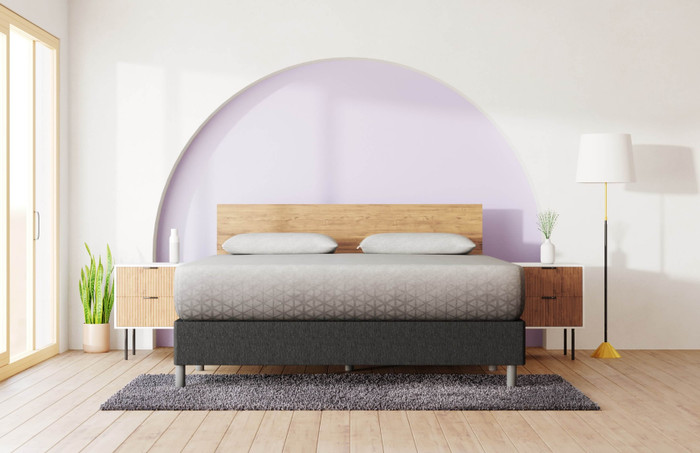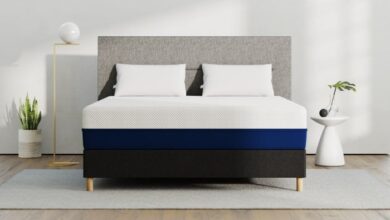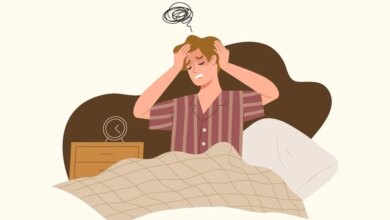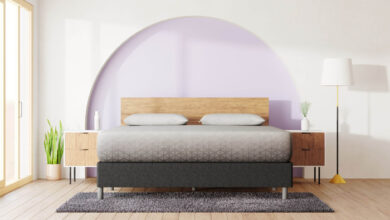What is Bedscaping? How Does the Right Mattress Matter for It?

November 4th, 2025 . 10 mins read
Key Takeaways
- Bedscaping blends design and wellness: It’s the art of styling your bed to look luxurious and inviting while promoting better comfort, mood, and sleep hygiene.
- The mattress is the foundation: A supportive, well-proportioned, and durable mattress gives structure, balance, and long-lasting beauty—no bedscape works without it.
- Style meets substance: Layer quality sheets, duvets, and pillows intentionally, follow a cohesive theme, and choose materials that reflect both your personality and restful living.
When you walk into a beautifully designed bedroom, the first thing that usually catches your eye is the bed. It’s the centerpiece of the space, and in recent years, a new design concept has emerged around it—bedscaping.
This growing trend is about much more than neatly arranging pillows or picking fancy bedcovers. It combines style, wellness, and sleep quality, with the bed and mattress at the heart of it all.
But here’s a key insight: no bedscape is complete without the right mattress.
You can style your bed with the most luxurious linens and chic décor, but if the mattress beneath doesn’t provide comfort, durability, and balance, the look falls apart—and so does your sleep quality.
| Best Budget Mattress for Simple, Cozy Setups: | Zoma Mattress |
| Best Hybrid Mattress for Balanced Design & Comfort: | Zoma Hybrid |
What is Bedscaping?
Bedscaping is the art of styling your bed in a way that enhances both its visual appeal and functional comfort. Think of it like landscaping for your outdoor space; but this time, the canvas is your bed.
It involves carefully layering bedding items such as sheets, duvets, quilts, throws, and decorative pillows to create a cohesive, polished look.
Unlike simply “making your bed,” bedscaping is intentional. It transforms your bed into a focal point—an inviting, styled centerpiece that reflects your personality and ties your bedroom together.
Why a Good Mattress is Essential for Bedscaping?
Here’s where most people go wrong: they focus on pillow colors and throws while ignoring the mattress. But bedscaping is only as good as the foundation it rests on.
Your mattress plays a dual role—it affects how your bedscape looks and how it feels. Let’s break it down:
1. Shape and Structure
The shape and structure of your mattress directly determine how polished your bedscape looks.
A mattress that sags in the middle or develops uneven lumps creates an unstable surface, which not only compromises your sleep quality but also ruins the clean, tailored appearance of your styled bed.
No amount of layering or decorative pillows can hide the fact that the foundation itself is flawed.
On the other hand, a supportive and well-structured mattress maintains a smooth surface that makes every bedspread, blanket, and accent piece fall neatly into place, giving your setup that magazine-worthy finish.
2. Height and Proportions
Proportion is everything in bedscaping. A mattress that’s too thin tends to look flat and underwhelming, almost like it’s missing substance, which makes the overall bedscape feel cheap and incomplete.
On the opposite end, an excessively bulky mattress can overwhelm the frame and throw off the symmetry of the design.
The sweet spot typically lies between 10 and 14 inches in height, where the mattress provides enough depth to create visual balance while still being practical.
This ideal proportion ensures your bedscape feels elevated, harmonious, and luxurious—without looking overdone.
3. Comfort and Functionality
At its core, bedscaping is not just about creating something that looks beautiful but about crafting a bed you genuinely love to spend time in. The comfort of the mattress plays a pivotal role in this.
A supportive mattress aligns with your body, relieves pressure points, and promotes restorative sleep, which transforms your styled bed into a space that’s equally inviting in appearance and in feel.
No matter how many layers of designer bedding you add, if the mattress doesn’t support restful sleep, the entire purpose of bedscaping is defeated. Beauty without comfort simply cannot last.
4. Durability and Longevity
A quality mattress does more than support sleep—it helps preserve the integrity of your bedscape over time.
High-density, durable mattresses maintain their shape for years, ensuring your bed always looks crisp and well-styled.
In contrast, low-quality or inexpensive mattresses tend to lose form quickly, leading to sagging areas that wrinkle your sheets and collapse the aesthetic you worked hard to create.
Investing in a mattress with durability means your bedscape remains fresh, stylish, and functional long-term, sparing you from the frustration of constantly adjusting linens to hide imperfections.
5. Materials and Aesthetic Influence
The material of your mattress doesn’t just impact comfort—it also plays a subtle but important role in the overall aesthetic of your bedscape.
For instance, memory foam mattresses often have sleek, uniform edges that give your bed a modern, streamlined look, while hybrid or innerspring mattresses with tufted tops add texture and a more traditional, plush appearance.
Natural and organic mattresses, made with materials like latex or cotton, can enhance a minimalist or eco-friendly bedscape by aligning with a “clean living” aesthetic.
Choosing the right mattress material ensures that your bedscape reflects not only your comfort needs but also your design vision, blending style with substance.
Why Bedscaping is More Than Just Decoration?
Some might view bedscaping as an Instagram trend or a magazine-inspired luxury.
But in reality, it goes beyond visual appeal. Bedscaping is about creating a sleep environment that influences your mood, health, and lifestyle.
1. Encourages Better Sleep Hygiene
One of the most underrated benefits of bedscaping is its role in improving sleep hygiene. When your bed looks inviting—layered with clean sheets, cozy pillows, and neatly styled covers—you’re naturally drawn to follow consistent bedtime habits.
Making the bed in the morning and preparing it at night creates small rituals that signal to your brain that it’s time to rest. Research supports this idea, showing that people who maintain such habits are more likely to experience better sleep quality.
A thoughtfully styled bed doesn’t just look good; it subtly trains your body and mind to respect the boundaries of rest.
2. Reduces Stress and Anxiety
The state of your surroundings often mirrors the state of your mind.
A cluttered or messy bedroom can contribute to feelings of restlessness and stress, while a neatly arranged bedscape provides a sense of order and calm.
Imagine walking into your room after a long, exhausting day and seeing a clean, well-made bed—it instantly feels like a personal retreat. Bedscaping transforms your bed into more than furniture; it becomes a stress-relief tool that promotes serenity.
By reducing visual clutter and introducing a sense of harmony, you create an atmosphere similar to that of a peaceful hotel room, where relaxation comes effortlessly.
3. Reflects Personality and Lifestyle
Your bedscape can be a direct reflection of who you are.
Minimalists may prefer crisp white bedding with sleek lines and subtle accents, while those with an artistic or free-spirited side might lean toward bold colors, mixed patterns, or layered textures.
Every detail—from the fabric choices to the way cushions are arranged—tells a story about your taste, lifestyle, and priorities.
Bedscaping allows you to personalize your sleeping environment in a way that feels authentic and expressive, making the bedroom a true extension of your personality rather than just another functional space.
4. Adds Luxury Without Remodeling
Not everyone has the budget or time for a complete bedroom renovation, but that doesn’t mean you can’t create a luxurious feel. Bedscaping is a cost-effective way to transform the entire atmosphere of your bedroom without tearing down walls or replacing furniture.
Investing in quality linens, layering throws, or adding accent pillows can instantly elevate the room. The result is a space that feels indulgent and high-end, even if the rest of the room remains simple.
In this way, bedscaping becomes an accessible design strategy for anyone who wants to experience the comfort of a boutique hotel without the expense of a full remodel.
5. Boosts Productivity and Daily Motivation
Starting the day with a neatly arranged bedscape sets a tone of accomplishment.
This small win early in the morning can create momentum, making you more motivated and focused throughout the day.
Psychologists often emphasize how tidiness in your personal space contributes to discipline and mental clarity.
When your bed looks styled and intentional, it encourages you to keep the rest of your environment organized, which can directly influence productivity levels.
6. Improves Bedroom Functionality
Bedscaping isn’t just about pretty arrangements—it also makes the bed more functional.
For example, using supportive pillows, breathable sheets, or layering for seasonal comfort ensures that your bed meets your physical needs as much as your aesthetic ones.
In this way, bedscaping combines form with function. You end up with a bed that not only looks beautiful but also enhances comfort, making lounging, reading, or even working from bed a more pleasant experience.
7. Creates a Hygienic Sleep Environment
An often-overlooked aspect of bedscaping is hygiene.
When you style and maintain your bed regularly, you’re more likely to wash linens, rotate pillows, and refresh bedding on schedule.
This simple habit reduces dust, allergens, and odors, which directly benefits your health, especially if you’re prone to allergies or skin sensitivities. A clean, styled bed doesn’t just look inviting—it also safeguards your overall well-being.
Choosing the Right Mattress for Bedscaping
1. Support and Comfort
No matter how stylish your bed looks, it won’t be enjoyable if the mattress itself isn’t comfortable. A mattress should provide proper spinal alignment, evenly distribute body weight, and relieve pressure points to promote restorative sleep.
Materials like memory foam, hybrids, and latex are especially popular for bedscaping because they pair durability with plush comfort. They create a smooth surface for styling while supporting your body for long nights of rest.
Ultimately, the comfort of your mattress is what makes your bedscape something you’ll appreciate beyond its visual appeal.
2. Mattress Size
The size of your mattress significantly affects how versatile your bedscape can be. Queen and king-size mattresses provide a broad canvas, making it easier to layer pillows, throws, and decorative accents without looking crowded.
However, smaller beds like twin or full can also be styled beautifully with the right proportions. The key is to scale your bedding choices—using fewer layers and more intentional accents—so the bed still feels balanced and inviting.
Regardless of size, a well-planned bedscape can transform any mattress into a stylish centerpiece of the bedroom.
3. Height and Thickness
Height plays a bigger role in bedscaping than many people realize.
A mattress between 10 and 14 inches in thickness usually strikes the ideal balance, providing enough depth for duvets and quilts to drape elegantly while avoiding the bulkiness of an oversized mattress.
Too thin, and the bed can look flat and unremarkable; too thick, and it may feel awkward or overwhelm the frame. A properly proportioned mattress allows for a layered, hotel-like look where every piece of bedding falls neatly into place.
4. Cooling and Breathability
Because bedscaping often involves layering multiple sheets, blankets, and throws, it’s important that the mattress doesn’t trap excessive heat.
A breathable, cooling mattress—featuring materials like gel-infused memory foam, open-cell latex, or hybrid designs with airflow-enhancing coils—keeps the bed comfortable year-round.
This ensures your styled bed is not only visually luxurious but also practical for everyday use. After all, a bedscape should invite you in, not make you feel overheated once you settle down.
5. Durability and Shape Retention
The best bedscape won’t stay beautiful if the mattress underneath starts to sag or lose its structure.
A durable mattress built with high-density foams or individually pocketed coils retains its shape over time, keeping your bedding smooth and photo-ready.
Shape retention also means fewer wrinkles in your sheets and a consistently polished look. Investing in a high-quality mattress ensures your bedscape looks fresh for years to come, sparing you from constant adjustments or premature replacements.
6. Edge Support for Structure
A mattress with strong edge support doesn’t just help you sleep comfortably—it also plays a role in styling.
Beds with reinforced edges hold their shape better, making the sides of your bed look firm and structured rather than sloping or sagging.
This stability makes it easier to tuck in sheets, layer blankets, and achieve that crisp, tailored look you often see in hotel rooms.
7. Motion Isolation for Undisturbed Styling
If you share your bed, motion isolation is another factor worth considering.
A mattress that absorbs movement prevents one side from shifting when the other person moves.
This not only improves sleep quality but also ensures your bedscape stays neat longer.
Less shifting means your carefully layered blankets and pillows stay in place instead of getting constantly rumpled.
8. Aesthetic Compatibility
While comfort and support are crucial, the look of the mattress itself can also matter for bedscaping. For example, some mattresses feature sleek edges, tufted tops, or organic fabrics that complement different design styles—from minimalism to luxury.
If you prefer a natural, eco-inspired aesthetic, organic latex or cotton-covered mattresses align beautifully with that theme. On the other hand, a smooth, modern memory foam design may better suit contemporary interiors.
9. Easy Maintenance and Care
Practicality is another factor that supports long-term bedscaping success. A mattress with a removable, washable cover or stain-resistant fabric can make upkeep much easier, keeping your bedscape looking fresh with less effort.
Some premium models also offer antimicrobial or hypoallergenic properties, which help prevent allergens, odors, and bacteria buildup. A low-maintenance mattress not only protects your health but also ensures your styled bed always looks inviting.
10. Warranty and Reliability
A mattress is an investment, and its longevity directly affects your bedscaping efforts. Choosing a mattress backed by a strong warranty provides peace of mind that it will retain its comfort, shape, and support for years.
Reliable brands that stand behind their products make it easier to maintain a consistently polished and luxurious bedscape without worrying about premature sagging or defects.
How To Elevate Your Bedscaping?
Once you’ve chosen the right mattress, here’s how to master bedscaping like a pro:
- Start with Quality Sheets: The foundation of any well-styled bed begins with high-quality sheets. Look for fabrics that are breathable, soft to the touch, and durable enough to last through frequent washes. Cotton percale, sateen, or even linen sheets work beautifully depending on the season and your comfort preference. Neutral tones like white, cream, or soft gray keep the design versatile, while subtle stripes or patterns can add depth without overpowering the look. Crisp sheets not only feel luxurious but also create a polished base for all your bedscaping layers.
- Add a Layered Comforter or Duvet: Once your sheets are in place, it’s time to build warmth and volume with a comforter or duvet. A fluffy duvet instantly creates that inviting, cloud-like appeal, while quilts or coverlets add texture and a cozy, layered feel. To achieve a designer touch, fold the duvet neatly halfway down the bed, exposing your crisp sheets and adding visual contrast. This styling technique mimics luxury hotels and makes your bed look instantly more welcoming and put together.
- Play With Pillows: Pillows are one of the most noticeable elements in bedscaping and can transform the entire look. Start with Euro shams or large square pillows at the back for height, add your regular sleeping pillows in the middle, and finish with smaller decorative cushions in front. The key is layering different sizes and textures while keeping the palette cohesive. Odd numbers, like three or five pillows, often look more natural and dynamic compared to perfectly even arrangements. You can also mix fabrics—such as velvet, cotton, or faux fur—to add richness and personality.
- Incorporate Throws and Blankets: Throws and blankets are the finishing touches that bring warmth, texture, and character to your bed. A chunky knit throw casually draped across the foot of the bed creates a relaxed, inviting look, while a lightweight woven blanket adds elegance and structure. Choose colors that either complement your existing bedding or provide a bold contrast to make the design pop. These layers not only elevate the style but also add practical comfort for cooler nights or afternoon naps.
- Stick to a Theme: To avoid a cluttered or mismatched look, it’s important to anchor your bedscaping design around a theme. Whether you prefer minimalist simplicity, a cozy bohemian vibe, or modern luxury, keeping the color scheme, textures, and accessories consistent will tie everything together. Your bed should feel like a natural extension of your bedroom décor, reflecting your personal style while maintaining harmony. A well-defined theme ensures that every element—from sheets to throws—works cohesively to create a visually stunning and comfortable retreat.
Bedscaping Trends You Should Know
To keep your bedroom fresh and modern, here are some trending bedscaping ideas:
- Minimalist Neutrals: Crisp whites and soft grays paired with a supportive mattress.
- Layered Luxury: Mixing different textures like velvet, linen, and faux fur.
- Color Pops: Neutral bedding with bold-colored throws or cushions for vibrancy.
- Eco-Friendly Styling: Organic cotton sheets, natural latex mattresses, and plant-based throws.
These trends not only enhance your bedroom’s look but also make your bed a healthier, more sustainable retreat.
Bedscaping as a Blend of Aesthetics and Sleep Wellness
At its core, bedscaping isn’t just about creating a stylish Instagram-worthy bed. It’s about blending aesthetics with wellness. Your bed should:
- Look beautiful enough to elevate your room’s ambiance
- Provide enough comfort to ensure restorative sleep
- Reflect your personal style and lifestyle choices
And none of that is possible without a mattress that balances support, comfort, and design harmony.
FAQs
What is bedscaping?
Bedscaping is the practice of styling your bed in a way that balances comfort, function, and aesthetics. Instead of just making your bed neatly, bedscaping involves layering sheets, duvets, pillows, and throws to create a cohesive, designer-inspired look.
It transforms the bed into the centerpiece of your room and reflects your personal style—whether minimalist, cozy, or luxurious. Beyond appearance, bedscaping also enhances comfort, making your sleeping space more inviting.
Why is the right mattress important for bedscaping?
A mattress is the foundation of bedscaping, and without the right one, even the most luxurious bedding won’t look or feel right. A supportive mattress provides structure, ensuring layers of sheets and duvets stay smooth rather than saggy or uneven.
The right mattress size also matters—it should be proportionate to your room and provide enough surface area for styling. For example, queen and king mattresses are ideal for bedscaping because they allow for more layering and decorative cushions.
How many pillows should I use for bedscaping?
The number of pillows depends on your personal style and bed size, but odd numbers usually create the most natural look. For a queen bed, three to five pillows are ideal, while a king bed may use up to seven.
Start with Euro shams or large square pillows at the back for structure, place standard sleeping pillows in the middle, and finish with decorative cushions or lumbar pillows at the front. Mixing textures like velvet, cotton, or faux fur adds visual interest and prevents the arrangement from looking flat or too uniform.
What type of sheets work best for bedscaping?
High-quality sheets are essential for bedscaping because they create the base for all other layers. Crisp cotton percale sheets give a cool, breathable, and hotel-like feel, while sateen sheets provide a silky, smooth finish with a subtle sheen.
Linen sheets are another great option for a relaxed, airy vibe, especially in warmer climates. Neutral shades like white, beige, and gray are versatile and timeless, but you can also choose soft patterns or muted pastels to add depth.
How can I make my bed look like a luxury hotel bed?
Achieving that “luxury hotel bed” look is all about layering and attention to detail. Start with freshly ironed, crisp sheets to create a flawless base. Add a fluffy duvet or comforter folded halfway down the bed to give volume and texture.
Layer pillows in a structured arrangement, using larger ones at the back and decorative cushions in front. A throw blanket draped casually at the foot of the bed adds softness and charm.
Do I need to follow a theme when bedscaping?
Yes, sticking to a theme ensures your bed looks intentional and cohesive rather than random or mismatched. A minimalist theme might use neutral tones, sleek bedding, and fewer pillows, while a bohemian theme could feature bold colors, textured throws, and patterned cushions.
Modern luxury, on the other hand, leans toward high-quality fabrics, structured arrangements, and elegant accessories. Your theme should also align with your bedroom décor, tying the whole space together. Having a theme doesn’t limit creativity—it simply helps guide your choices so every element contributes to a unified, polished design.
Final Takeaway
Bedscaping is more than decoration—it’s a lifestyle choice that combines design, health, and comfort. While pillows, sheets, and throws add personality, the mattress is the foundation that holds it all together.
A high-quality, supportive mattress ensures that your bedscape looks polished and feels restful every single night.
So, before you rush to buy decorative cushions or designer bedding, start at the core: invest in the right mattress. Build from there, and you’ll have a bed that’s not only visually stunning but also deeply rejuvenating.
This article is for informational purposes and should not replace advice from your doctor or other medical professional.


